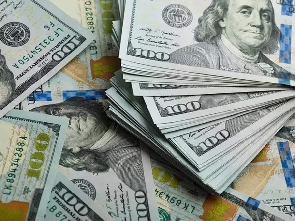- Home - News
- TWI News | TV
- Polls
- Year In Review
- News Archive
- Crime & Punishment
- Politics
- Regional
- Editorial
- Health
- Ghanaians Abroad
- Tabloid
- Africa
- Religion
- Election 2020
- Coronavirus
- News Videos | TV
- Photo Archives
- News Headlines
- Press Release
Business News of Thursday, 19 September 2013
Source: Joy Online
Bank of Ghana keeps policy rate at 16 percent
The Bank of Ghana has maintained its policy rate for the second time this year. It left the key lending rate for commercial banks at 16 percent.
This is likely to influence the loan that you want to take from a commercial bank or the one that you are servicing.
Addressing journalists after meeting to review the health of the economy, Governor, Dr. Kofi Wampah says they had to keep the rate because of some treats to inflation, economic growth and revenue mobilization
Below is state his ment
1. Members of the Press, let me once again welcome you to the press briefing on the MPC’s assessment of economic developments over the past eight months of the year, the outlook and the positioning of the policy rate.
Global Economic Developments
2. Global economic policy discourse has continued to centre on the challenges facing the world economy and the policy actions needed to strengthen economic recovery. While global coordinated action had helped to stabilize the world economy and the financial markets, more remains to be done to boost global economic growth.
3. Growth remains subdued, while market volatility and stability risks persist. Economic activity in advanced economies has recorded some improvements. In contrast, the growth momentum in emerging and developing markets has slowed, with challenges arising from domestic and external developments.
4. Inflation is expected to remain generally stable in advanced countries, supported by a slowdown in commodity price movements. In major emerging market economies, however, inflation is relatively higher, a problem that has been magnified by the exchange rate depreciation of recent months. The external financing conditions that have led to the sell-offs in emerging market currencies in recent months could also drive up inflation pressures.
5. Commodity prices remained bearish on the international markets. On the average, crude oil prices are projected at US$104 per barrel, while gold prices are projected to inch up slightly to US$1,360 per ounce by the end of 2013. Similarly, cocoa prices are expected to rally amid concerns about unfavourable weather conditions in the major producing countries, as prices move towards US$2,300 per tonne by year end. However, these commodity prices are subject to risk factors such as global uncertainties and geopolitical tensions.
6. These projections in the external environment could impact the domestic economy in the second half, as trends in commodity prices continue to affect external sector performance.
Domestic Economic Developments
Inflation and Growth
7. The latest inflation numbers show that after six consecutive months of increases in headline inflation, which pushed the inflation rate to 11.8 percent in July, inflation fell marginally to 11.5 percent at the end of August. This downturn was driven mainly by favourable developments in the non-food prices after persistent increases since the beginning of the year, an indication that the pass-through effects of earlier petroleum price adjustments may be ending. However, food prices surprised on the upside, probably awaiting the harvest season to kick-in. All the Bank’s measures of core inflation indicate some easing in underlying inflation.
8. An update of the Bank’s Composite Index of Economic Activity (CIEA) in July 2013 suggests increased momentum in economic activity. The real CIEA improved to 350.1, from 326.9 in July 2012, representing a year-on-year growth of 7.1 percent. Driving this pace of activity were industrial electricity consumption, exports, manufacturing sales, DMBs credit to the private sector, sales of cement and domestic VAT. The positive growth recorded in these variables was partially offset by contractions in port activity, SSNIT contributions and imports.
9. The Bank of Ghana’s survey of consumer confidence showed lower sentiments and heightened inflation expectations as the index declined to 95.6 in August from 101.1 in June 2013. Although, overall business confidence index declined in the second quarter, businesses were optimistic about company prospects in the third quarter.
Government Fiscal Operations
10. Preliminary fiscal data for the first seven months of the year indicate that both revenue and expenditure remained below their respective targets. However, the shortfall in revenue was much higher than the reduction in expenditure.
11. Total revenue and grants was GH¢10.4 billion, lower than the target of GH¢12.5 billion mainly as a result of shortfalls in domestic revenue collections and low disbursement of grants. Of this outturn, domestic revenue totalled GH¢9.8 billion, below the target of GH¢11.6 billion. Total tax revenue amounted to GH¢7.7 billion, lower than the target of GH¢9.1 billion. Grant disbursements were GH¢542 million, falling short of its target by 41.7 percent. Non-tax revenues amounting to GH¢2.1 billion for the period also missed the target by 12.4 per cent.
12. Total expenditure including clearance of arrears and outstanding commitments amounted to GH¢16.0 billion, lower than the budget target of GH¢17.5 billion. However, compensation of employees exceeded its target of GH¢5.1 billion and amounted to GH¢5.5 billion. Similarly, interest payments totalling GH¢2.6 billion, breached its target of GH¢1.8 billion.
13. The above developments resulted in a fiscal deficit (cash basis) equivalent to 6.3 percent of GDP against a target of 5.6 percent. The deficit was financed mainly from domestic sources, resulting in a Net Domestic Financing (NDF) of GH¢4.4 billion, higher than the budget target of GH¢3.6 billion. Foreign financing of the budget amounted to GH¢1.3 billion, marginally lower than the GH¢1.5 billion target. Financing from Bank of Ghana amounted to GH¢1.0 billion, equivalent to 4.9 percent of projected revenue.
14. The stock of public debt increased to GH¢43.9 billion (49.5% of GDP) at end of August 2013, from GH¢35.1 billion in December 2012. Of this, the domestic component amounted to GH¢24 billion compared to GH¢18.5 billion in December 2012. External debt stood at US$10.2 billion, up from US$8.8 billion in December 2012. The increase in the external debt was mainly due to the sovereign bond issue.
Monetary and Banking Sector Developments
15. Growth in monetary aggregates moderated further in July 2013. Broad money supply (M2+) grew by 4.4 percent in July 2013, compared with 29.6 percent in the same period last year. This continued to be driven by declines in the annual growth of foreign currency deposits to -0.2 percent in July 2013 compared to 34.4 percent in the same period in 2012.
16. The August 2013 Bank of Ghana survey of credit conditions again showed a net easing of credit conditions. With the exception of long term credit, which saw some tightening, the credit stance for all other loan types including credit to SMEs, large enterprises, short-term and mortgage loans eased during the period.
17. The annual growth of private sector credit moderated to 28.1 percent in nominal terms at the end of July 2013, from 41.3 percent in July 2012. Similarly, the annual growth of real private sector credit was 15 percent in July 2013, down from 29 percent in July 2012.
18. The banking industry remained well capitalized, liquid and profitable. Total assets increased to GH¢31.6 billion as at the end of July 2013, compared with GH¢24.3 billion in July 2012. This was driven mainly by advances, which accounted for 48.5 per cent of the total. The asset growth was funded by deposits which recorded an annual growth of 15.7 per cent to GH¢20.3 billion at the end of July 2013.
19. The Non-Performing Loans (NPL) ratio within the banking industry was 12.9 percent in July 2013, down from 13.4 percent in July 2012, while the ratio excluding the loss category also fell to 5.3 percent from 6.4 percent in the same period.
20. Interest rates on the money market recorded slight declines. Between December 2012 and August 2013:
• The 91-day Treasury bill rate declined to 22.8 from 23.1 percent, while the 182-day Treasury bill rate fell to 22.3 from 23 percent.
• The 1-year note reduced to 21.9 from 22.9 percent, while the 2-year note declined to 22 from 23 percent.
• The 3-year bond rate fell to 19.24 from 21 percent.
• The yield curve was lengthened with the introduction of the 7-year bond which was issued at 17.5 percent.
21. The weighted average interbank rate declined to 17.1 percent in August 2013, from 17.5 percent in December 2012.
External Sector Developments
22. For the first half year of 2013, the balance of payments improved as it recorded a lower deficit of US$677.8 million compared with a deficit of nearly US$2 billion in the corresponding period of last year. This was largely due to increased net inflows into the financial account, and a slight improvement in the deficit on the current account.
23. The current account balance at the end of the first half of 2013 improved to a deficit of US$2.3 billion from a deficit of US$2.5 billion recorded in the corresponding period of 2012. This was as a result of a slowdown in non-oil imports and an improvement in net outflows from the services, income and transfers account.
24. The capital and financial accounts on the other hand recorded a surplus of US$1.5 billion, compared with a surplus of US$491.1 million in the corresponding period of 2012. This development was largely driven by large net inflows of short term capital that over-compensated for net outflows in direct and portfolio investments.
25. For the first eight months of the year, the value of merchandise exports were estimated at US$9.8 billion, improving by 4.1 percent over the outturn for the same period last year. As a result of a decline in international prices of our major export commodities, earnings from gold fell by 12.6 percent to US$3.4 billion, while exports of cocoa beans also declined by 21.4 percent to US$1.4 billion. Oil exports, however, increased by 46.9 percent to US$2.8 billion, as a result of increased production. Earnings from non-traditional exports, including cocoa products, went up by 22.2 percent to US$2.2 billion.
26. The value of imports also declined in the first eight months of the year, to US$11.6 billion from US$11.9 billion in 2012. The decline came from a slowdown in both oil and non-oil imports. Oil imports went down by US$60.9 million to US$2.3 billion, while non-oil imports also declined by 2.4 percent to US$9.3 billion within the period. The trade balance for the period therefore improved to a deficit of US$1.8 billion from a deficit of US$2.5 billion in 2012.
27. In the first eight months of 2013, the Ghana cedi cumulatively depreciated at a slower rate of 3.9 percent against the US dollar, compared with a depreciation of 18.4 percent during the same period in 2012. In trade weighted terms, the real effective rate appreciated by 3.2 percent during the period.
28. Private inward transfers received through the banking system from January to July 2013 declined to US$9.7 billion from US$10.5 billion for the same period in 2012. Of the total transfers, US$1 billion accrued to individuals representing a decline of 1.5 percent over the outturn in the same period of 2012.
29. Gross international reserves increased to US$5.8 billion (3.2 months of imports) in August 2013 from a stock position of US$5.3 billion (3 months of import cover) at the end of December 2012.
Summary and Outlook
30. In summary, global economic conditions remain mixed as recovery in advanced economies continues to be countered by a slowdown in emerging markets. These together with trends in commodity prices continue to pose significant risks to the external outlook with direct implications for the domestic economy.
31. The external sector was partly affected by the recent developments on the global front, especially with weak commodity prices in the first half and a slowdown in portfolio inflows. Although the overall impact has been muted by slower growth in imports and significant improvements in the capital and financial accounts, risks to the outlook continue to emanate from uncertainties in the global financial markets.
32. The volatility in the foreign exchange market has reduced significantly this year. Going forward to the end of the year, it is expected that pressures in the foreign exchange markets would ease further with the impending inflows of the cocoa syndication loan and the MDBS disbursements, subject to seasonal demand pressures.
33. The implementation of the budget for the first seven months of the year revealed that fiscal pressures still persist arising mainly from significant shortfalls in domestic revenue collections and the delay in the removal of utility subsidies.
34. On the outlook for inflation, the Committee noted that even though inflation had declined in August, upside risks remained. In particular, there has been further adjustment in petroleum prices and transport fares in September. There is also the possibility of adjustment of utility tariffs in the fourth quarter. The uncertainty in commodity prices also poses risks to inflation. These risks could however be moderated by an improved harvest, relative stability in the foreign exchange market supported by the syndicated cocoa loan, and subdued global inflation. The Committee noted that although the inflation forecast has improved at this MPC round, the central path remains slightly above the upper limit of the target band. Barring any shocks, inflation could move back to the target range by the first half of 2014.
35. On the growth outlook, the Committee observed that economic activity had picked up, evidenced by positive developments in the CIEA and the credit stance of DMBs as well as increased oil production. However, the downside risks include budgetary cutbacks in domestic financed capital expenditures and spending on goods and services in favour of recurrent expenditures such as wages and salaries. Softening consumer sentiments may also pose a downside risk to the growth outlook.
36. On the balance of risks, the Committee held the view that risks in the outlook for inflation and growth are balanced and therefore decided to keep the policy rate unchanged at 16 percent.











